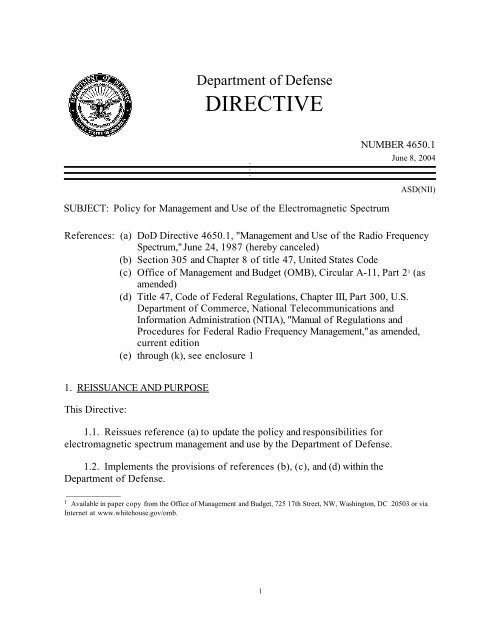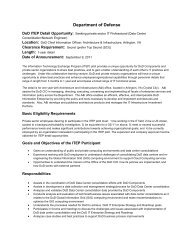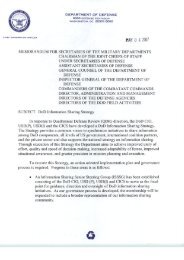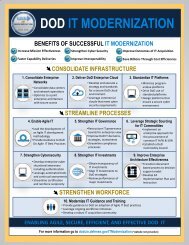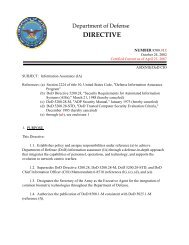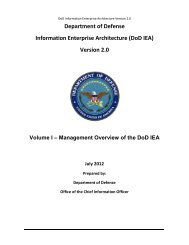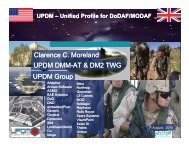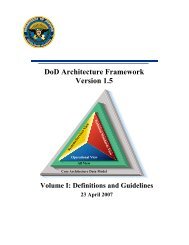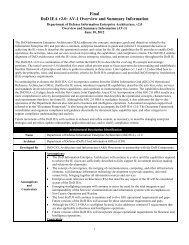DoD Directive 4650.1, June 8, 2004
DoD Directive 4650.1, June 8, 2004
DoD Directive 4650.1, June 8, 2004
Create successful ePaper yourself
Turn your PDF publications into a flip-book with our unique Google optimized e-Paper software.
Department of DefenseDIRECTIVENUMBER <strong>4650.1</strong><strong>June</strong> 8, <strong>2004</strong>SUBJECT: Policy for Management and Use of the Electromagnetic SpectrumASD(NII)References: (a) <strong>DoD</strong> <strong>Directive</strong> <strong>4650.1</strong>, "Management and Use of the Radio FrequencySpectrum," <strong>June</strong> 24, 1987 (hereby canceled)(b) Section 305 and Chapter 8 of title 47, United States Code(c) Office of Management and Budget (OMB), Circular A-11, Part 2 1 (asamended)(d) Title 47, Code of Federal Regulations, Chapter III, Part 300, U.S.Department of Commerce, National Telecommunications andInformation Administration (NTIA), "Manual of Regulations andProcedures for Federal Radio Frequency Management," as amended,current edition(e) through (k), see enclosure 11. REISSUANCE AND PURPOSEThis <strong>Directive</strong>:1.1. Reissues reference (a) to update the policy and responsibilities forelectromagnetic spectrum management and use by the Department of Defense.1.2. Implements the provisions of references (b), (c), and (d) within theDepartment of Defense._______________1Available in paper copy from the Office of Management and Budget, 725 17th Street, NW, Washington, DC 20503 or viaInternet at www.whitehouse.gov/omb.1
DODD <strong>4650.1</strong>, <strong>June</strong> 8, <strong>2004</strong>2. APPLICABILITYThis <strong>Directive</strong> applies to the Office of the Secretary of Defense, the MilitaryDepartments, the Chairman of the Joint Chiefs of Staff, the Combatant Commands, theOffice of the Inspector General of the Department of Defense, the Defense Agencies,<strong>DoD</strong> Field Activities, and all other organizational entities in the Department of Defense(hereafter referred to collectively as "the <strong>DoD</strong> Components").3. DEFINITIONSTerms used in this <strong>Directive</strong> are defined in enclosure 2.4. POLICYIt is <strong>DoD</strong> policy that:4.1. The electromagnetic spectrum (hereafter referred to as "spectrum") is acritical, finite national resource. Access to the spectrum is vital to the support ofmilitary operations. Proper management and use of the spectrum available to theDepartment shall be an integral part of, and essential to, military planning, research,development, testing, and operations involving spectrum-dependent systems.4.2. The spectrum management function shall be accomplished at a levelthoroughly familiar with, and immediately responsive to, the requirements of theoperating forces and sufficiently close to major policy-making offices to facilitatereferral of issues requiring consideration by these offices.4.3. Spectrum policy and spectrum management functions shall be guided by thefollowing five core principles:4.3.1. Support a U.S. spectrum policy that balances national and economicsecurity, with national security as the first priority.4.3.2. Ensure the U.S. warfighter has sufficient spectrum access to supportmilitary capabilities.4.3.3. Use the spectrum as efficiently and effectively as possible and give dueregard to the rights of other spectrum users.4.3.4. Commit to continue investing in new, spectrum-efficient technologies,and use new technology to support the increasing demand for additional spectrum.2
DODD <strong>4650.1</strong>, <strong>June</strong> 8, <strong>2004</strong>4.3.5. Actively support U.S. policies and interests in international spectrumbodies and in international and bilateral negotiations for spectrum allocation and use.4.4. Spectrum requirements shall be based on current and projected militaryoperational requirements, and spectrum available to the Department shall be utilized in amanner to provide the greatest overall benefit to <strong>DoD</strong> missions.4.5. The <strong>DoD</strong> Component that is developing or acquiring spectrum-dependentequipment or systems shall make a written determination, with the concurrence of the<strong>DoD</strong> Component or Component Chief Information Officer (CIO), that there isreasonable assurance of spectrum supportability. Efforts to obtain spectrumsupportability for spectrum-dependent equipment or systems being developed shall beinitiated as early as possible during the Technology Development Phase.4.5.1. No spectrum-dependent systems being developed shall proceed into theSystem Development and Demonstration Phase without such a spectrum supportabilitydetermination unless specific authorization to proceed is granted by the MilestoneDecision Authority (MDA). (See subparagraph 5.4.2.5.)4.5.2. No spectrum-dependent system shall proceed into the Production andDeployment Phase without such a spectrum supportability determination unless specificauthorization to proceed is granted by the Under Secretary of Defense for Acquisition,Technology, and Logistics (USD(AT&L)) or a waiver is granted by the AssistantSecretary of Defense for Networks and Information Integration (ASD(NII)). (Seesubparagraph 5.4.2.5.)4.5.3. No spectrum-dependent "off-the-shelf" or other non-developmentalsystem shall be purchased or procured without such a spectrum supportabilitydetermination.4.6. Consideration shall be given, in accordance with existing Federal regulatoryprocedures, toward sharing the spectrum with other Federal Agencies and withcommercial spectrum users. The sharing of the electromagnetic spectrum used by theDepartment with other Federal Agencies and or commercial spectrum users shall beaccomplished only under the following conditions:4.6.1. Without degradation to the Department's mission.4.6.2. In a manner that provides current and future <strong>DoD</strong> users with sufficientregulatory protection; and3
DODD <strong>4650.1</strong>, <strong>June</strong> 8, <strong>2004</strong>4.6.3. With minimal risk that such sharing will result in loss of access to thespectrum necessary to perform the <strong>DoD</strong> mission.5. RESPONSIBILITIES5.1. Pursuant to <strong>DoD</strong> <strong>Directive</strong> 5137.1 (reference (e)), the Assistant Secretary ofDefense for Networks and Information Integration/Department of Defense ChiefInformation Officer (ASD(NII)/<strong>DoD</strong> CIO), as the Principal Staff Assistant on spectrummatters, both within the Department and for Departmental spectrum matters presentedbefore international, regional, and national spectrum management forums, shall:5.1.1. Provide direction and guidance within the Department of Defense formanaging and using the electromagnetic spectrum, including implementation ofapplicable provisions of references (b) through (d) and <strong>DoD</strong> <strong>Directive</strong> 3222.3(reference (f)).5.1.2. Direct the establishment and maintenance of a capability to analyze andmake recommendations concerning whether spectrum-dependent systems, either beingacquired or procured, have, or will have, spectrum supportability.5.1.3. When appropriate, issue specific authorization for acquisitions andacquisition programs to proceed without spectrum supportability under subparagraphs4.5.1. and 4.5.2., above.5.1.4. Provide direction and guidance for the development of <strong>DoD</strong> positionsfor, and <strong>DoD</strong> participation in, international and regional spectrum forums, including allrelated national, regional, and international preparatory activities for the InternationalTelecommunication Union World Radio Communication Conferences.5.1.5. Develop and maintain a Strategic Plan for management and use of thespectrum that establishes goals, objectives, measures, and responsibilities to ensure<strong>DoD</strong> spectrum needs are met and that the Department is making the most efficient andeffective use of available spectrum.5.1.6. Promote coordination and cooperation between the Department andother Federal Agencies, the civilian community, and other domestic, regional, andinternational organizations and forums to ensure that <strong>DoD</strong> spectrum needs and issuesare addressed adequately.4
DODD <strong>4650.1</strong>, <strong>June</strong> 8, <strong>2004</strong>5.1.7. Direct the establishment and maintenance of a capability to documentand manage existing spectrum assets and to perform required electromagneticcompatibility (EMC) analyses and studies to support effective use ofspectrum-dependent systems in electromagnetic environments and accomplish nationalsecurity and military objectives in accordance with reference (f).5.1.8. For Major Defense Acquisition Programs and Major AutomatedInformation System acquisition programs, provide an assessment of spectrumsupportability to the MDA at acquisition milestones.5.2. The Under Secretary of Defense, Acquisition, Technology, and Logistics(USD(AT&L)) shall:5.2.1. In coordination with the ASD(NII), establish policy for acquiringspectrum-dependent systems and ensure compliance with spectrum supportabilityrequirements within the acquisition process (<strong>DoD</strong> <strong>Directive</strong> 5000.1 and <strong>DoD</strong> Instruction5000.2 (references (g) and (h))).5.2.2. When appropriate, issue specific authorization for acquisitions andacquisition programs to proceed without spectrum supportability under subparagraphs4.5.1. and 4.5.2., above.5.2.3. Promote innovative technologies to optimize use and effectiveness ofavailable spectrum resources, to include advanced concept development, internationalcooperation, and evolutionary acquisitions.5.2.4. Provide support and oversight as necessary, prior to and through thedevelopmental test and evaluation phase of systems, to require and verify that spectrumsupportability requirements have been addressed.5.3. The Director, Operational Test and Evaluation (DOT&E), shall:5.3.1. Monitor and review test and evaluation (T&E) of spectrum-dependentequipment or systems to ensure the <strong>DoD</strong> Components developing spectrum-dependentequipment have requested and implemented, as applicable, spectrum supportabilityguidance prior to T&E. (See <strong>DoD</strong> <strong>Directive</strong> 5141.2 (reference (i)).)5.3.2. Assess, prior to the commencement of T&E, the adequacy of spectrumresources required for T&E and provide recommendations in respect thereof forprograms under DOT&E oversight.5
DODD <strong>4650.1</strong>, <strong>June</strong> 8, <strong>2004</strong>5.4. The Heads of the <strong>DoD</strong> Components shall:5.4.1. Implement within their organizations applicable provisions ofreferences (b), (c), and (d) and <strong>DoD</strong> issuances regarding spectrum management.5.4.2. For spectrum-dependant systems for which they or their organizationshave responsibility:5.4.2.1. Promote the use of innovative spectrum-efficient technologies.5.4.2.2. Submit, through appropriate channels to the MilitaryCommunications - Electronics Board (MCEB), requests for a spectrum supportabilityassessment as early as possible prior to the development or procurement of anyspectrum-dependent equipment or system and fully address MCEB guidance andrecommendations. Requests for spectrum supportability assessments shall includeidentification of those Host Nations into which deployment is likely or planned.5.4.2.3. Not procure or purchase off-the-shelf or othernon-developmental spectrum-dependent systems without first requesting spectrumsupportability guidance from the MCEB, fully considering that guidance and making thedetermination required by paragraph 4.5.5.4.2.4. Require that MDAs and or Component Acquisition Executives(CAEs) within their organizations obtain spectrum supportability when acquiringspectrum-dependent equipment or systems and promote use of innovative spectrumefficient technologies.5.4.2.5. Provide a justification and plan to obtain spectrum supportabilityto the USD(AT&L), the ASD(NII), the DOT&E, and the Chair, MCEB, whenever aspectrum-dependent system that has not obtained spectrum supportability is authorizedto proceed into the System Development and Demonstration Phase or into theProduction and Deployment Phase under subparagraphs 4.5.1. or 4.5.2.5.4.2.6. Obtain and address MCEB spectrum supportability guidanceduring the developmental and operational T&E of spectrum-dependent equipment andsystems.6
DODD <strong>4650.1</strong>, <strong>June</strong> 8, <strong>2004</strong>5.5. The Chairman of the Joint Chiefs of Staff and the MCEB shall:5.5.1. Represent the interests of the Commanders of the CombatantCommands related to operational spectrum management matters in accordance with<strong>DoD</strong> <strong>Directive</strong> 5158.1 (reference (j)).5.5.2. Recommend policies to the ASD(NII) and procedures in accordancewith <strong>DoD</strong> <strong>Directive</strong> 5100.35 (reference (k)).5.5.3. Provide, on behalf of the Commanders of the Combatant Commands,operational direction for spectrum management-related issues to the Commander, JointSpectrum Center to include, but not be limited to spectrum databases, analytical tools,and operational-spectrum requirements.5.6. The Secretaries of the Military Departments shall:5.6.1. Implement spectrum management within their respective MilitaryDepartments in accordance with this and other applicable directives.5.6.2. Provide members to the Interdepartment Radio Advisory Committee(IRAC) and its substructure, as defined in reference (d), to represent their respectivedepartmental interests.5.6.3. Provide, when requested or authorized by the ASD(NII)/<strong>DoD</strong> CIO,representation to U.S. delegations at non-IRAC national and/or internationalspectrum-related forums.5.6.4. Ensure their respective Department's spectrum management interestsare represented within the MCEB and its panels and working groups (reference (k)).7
DODD <strong>4650.1</strong>, <strong>June</strong> 8, <strong>2004</strong>6. EFFECTIVE DATEThis <strong>Directive</strong> is effective immediately.Enclosures - 2E1. References, continuedE2. Definitions8
DODD <strong>4650.1</strong>, <strong>June</strong> 8, <strong>2004</strong>E1. ENCLOSURE 1REFERENCES, continued(e) <strong>DoD</strong> <strong>Directive</strong> 5137.1, "Assistant Secretary of Defense for Command, Control,Communications, and Intelligence (ASD(C3I))," February 12, 1992(f) <strong>DoD</strong> <strong>Directive</strong> 3222.3, "Department of Defense Electromagnetic CompatibilityProgram (EMCP)," August 20, 1990(g) <strong>DoD</strong> <strong>Directive</strong> 5000.1, "The Defense Acquisition System," May 12, 2003(h) <strong>DoD</strong> Instruction 5000.2, "Operation of the Defense Acquisition System,"May 12, 2003(i) <strong>DoD</strong> <strong>Directive</strong> 5141.2, "Director of Operational Test and Evaluation (DOT&E),"May 25, 2000(j) <strong>DoD</strong> <strong>Directive</strong> 5158.1, "Organization of the Joint Chiefs of Staff and Relationshipswith the Office of the Secretary of Defense," May 1, 1985(k) <strong>DoD</strong> <strong>Directive</strong> 5100.35, "Military Communications-Electronics Board,"March 10, 19989 ENCLOSURE 1
DODD <strong>4650.1</strong>, <strong>June</strong> 8, <strong>2004</strong>E2. ENCLOSURE 2DEFINITIONSE2.1.1. Component Acquisition Executive (CAE). The individual responsible foroverall acquisition management in his or her respective organization and their respectiveComponent. The Secretaries of the Military Departments or the Heads of Agencieswith authority to re-delegate are the CAEs for each of the Components.E2.1.2. Electromagnetic Compatibility (EMC). The ability of systems, equipment,and devices that utilize the electromagnetic spectrum to operate in their intendedoperational environments without suffering unacceptable degradation or causingunintentional degradation because of electromagnetic radiation or response. It involvesthe application of sound electromagnetic spectrum management; system, equipment, anddevice design configuration that ensures interference-free operation; and clear conceptsand doctrines that maximize operational effectiveness.E2.1.3. Electromagnetic (EM) Environment (EME). The resulting product of thepower and time distribution, in various frequency ranges, of the radiated or conductedelectromagnetic emission levels that may be encountered by a military force, system, orplatform when performing its assigned mission in its intended operational environment.It is the sum of electromagnetic interference, electromagnetic pulse, hazards ofelectromagnetic radiation to personnel, ordnance, and volatile materials, and naturalphenomena effects of lightning and precipitation static.E2.1.4. Electromagnetic Spectrum. The range of frequencies of EM radiationfrom zero to infinity. For the purposes of this <strong>Directive</strong>, "electromagnetic spectrum"shall be defined to be the range of frequencies of EM radiation that has been allocatedfor specified services under the U.S. and international tables of frequency allocation(reference (d)), together with the EM spectrum outside the allocated frequency rangewhere use of unallocated frequencies could cause harmful interference with theoperation of any services within the allocated frequency range. The terms"electromagnetic spectrum," "radio frequency spectrum," and "spectrum" shall besynonymous.10 ENCLOSURE 2
DODD <strong>4650.1</strong>, <strong>June</strong> 8, <strong>2004</strong>E2.1.5. Equipment Spectrum Certification. The statement(s) of adequacy receivedfrom authorities of sovereign nations after their review of the technical characteristicsof a spectrum-dependent equipment or system regarding compliance with their nationalspectrum management policy, allocations, regulations, and technical standards.Equipment Spectrum Certification is alternately called "spectrum certification." 2E2.1.6. Host Nations (HNs). Those sovereign nations, including the United States,in which the Department of Defense plans or is likely to conduct military operationswith the permission of that nation.E2.1.7. Milestone Decision Authority (MDA). The designated individualresponsible for an acquisition program. The MDA shall have the authority to approvethe entry of an acquisition program into the next phase of the acquisition process andshall be accountable for cost, schedule, and performance reporting to higher authority,including Congressional reporting.E2.1.8. Spectrum-Dependent Systems. Those electronic systems, subsystems,devices and/or equipment that depend on the use of the electromagnetic spectrum forthe acquisition or acceptance, processing, storage, display, analysis, protection,disposition, and transfer of information.E2.1.9. Spectrum Management. The planning, coordinating, and managing of thejoint use of the electromagnetic spectrum through operational, engineering, andadministrative procedures. The objective of spectrum management is to enableelectronic systems to perform their functions in the intended environment withoutcausing or suffering unacceptable interference._____________2Within the United States and its possessions, the requirement for certification of <strong>DoD</strong> spectrum-dependent equipment isdictated by OMB Circular A-11, Part 2 (reference (c)). The NTIA "Manual of Regulations and Procedures for Federal RadioFrequency Management" (reference (d)) prescribes procedures and also applies to all equipment or systems employingsatellite techniques.11 ENCLOSURE 2
DODD <strong>4650.1</strong>, <strong>June</strong> 8, <strong>2004</strong>E2.1.10. Spectrum Supportability. The assessment as to whether theelectromagnetic spectrum necessary to support the operation of a spectrum-dependentequipment or system during its expected life cycle is, or will be, available (that is, fromsystem development, through developmental and operational testing, to actual operationin the electromagnetic environment). The assessment of "spectrum supportability"requires, at a minimum, receipt of equipment spectrum certification, reasonableassurance of the availability of sufficient frequencies for operation from HNs, and aconsideration of EMC. 3____________3While an actual determination of spectrum supportability for a spectrum-dependent system within a particular country(i.e., Host Nation) may be possible based upon "spectrum supportability" (e.g., equipment spectrum certification) commentsprovided by that host nation, the overall determination of whether a spectrum-dependent system has spectrumsupportability is the responsibility of the MDA based upon the totality of spectrum supportability comments returned fromthose host nations whose comments were solicited.12 ENCLOSURE 2


